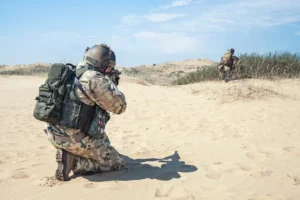
The Battle of Iwo Jima marks one of the most iconic battles in World War II History. The famous Raising of the Flag on Iwo Jima, taken February 23, 1945, is one of the most well-known photographs in the world.
The fierce battle lasted for over a month, from February 19 to March 26, and resulted in the deaths of 6,821 American soldiers. An Additional 19,217 soldiers were wounded. The battle resulted in a strategic victory for the Allied forces, and 27 military personnel were awarded the Medal of Honor for their actions.
Hell on Earth
As a halfway point between the Marianas Islands and Japan, Iwo Jimas three airfields were strategically important for the Americans planned invasion of Okinawa. Troops stationed on the island would provide assistance to American troops, and the location would provide a base for Allied pilots and act as a refueling stop. Taking control of Iwo Jima would also eliminate the threat of Japanese planes stationed on the island.
The Japanese stationed over 20,000 troops on Iwo Jima, and built a series of caves and tunnels for both protection and strategic attacks.
The Americans first spent several months bombing and bombarding the island with air strikes and battleships. On Feb. 19, the first wave of 30,000 Marines invaded Iwo Jima.
The islands shore was flat and exposed, offering little shelter. The Japanese had prepared for the coming invasion, and let the Marines advance far onto the beach before they opened fire. Once the Marines reached the hidden Japanese bunkers, the Japanese opened fire handing devastating losses to American forces. Many of the bunkers were connected with hidden tunnels, meaning that even if a bunker was cleared by a soldier with a flamethrower or grenade, more Japanese fighters would emerge later and continue firing.
American progress on the Island was slow, but steady. Support from offshore battleships, and several brave charges helped the Marines make significant ground inward on the island. More than 70,000 Marines, Navy corpsman, and Air Force members attacked the island relentlessly, weakening Japanese defenses. The Japanese forces on the island were almost totally destroyed. 18,844 died from either fighting or by ritual suicide.
After 25 days of intense fighting, the island was official declared secure at 9 a.m. on March 16, 1945.
Raising the Flag

Mount Suribachi, a dormant volcanic cone, was the main geographical feature on the island. From the top of the mountain, the Japanese were able to spot and target American troops as they landed, which made it very valuable from a strategic vantage point.
On February 23, a combat patrol of 40 men climbed the mountain with a goal of securing it for the Americans. Though the troops expected to come under heavy fire, many of the Japanese were hidden in caves and tunnels, and the patrol met with little resistance.
The commander who sent the troops to the summit initially sent a small American flag with the patrol to be raised if they reached the top. It was attached to a length of pipe, and flown over the mountain. The sight of the stars and stripes flying over Japanese land provided a huge boost of morale to the soldiers fighting below.
The roar of cheering American soldiers and blasting ship horns alerted the Japanese to the events on the mountain, and many Japanese came out of hiding to attack. While the Marines faced more attacks on the way down the mountain than they did on the way up, the combat patrol was able to quickly dispatch the renewed enemy threats.
The famous photograph taken by Joe Rosenthal was actually of a second flag which was raised later in the day. The first flag was relatively small, and a larger one was located to take its place.
Several Marines were on top of the mountain after the first flag raising, placing a telephone wire on top of the mountain. These Marines joined four others sent from below with the new flag, and took part in the now-famous photograph. Pictured in the photo are Ira Hayes, Franklin Sousley, Michael Strank, John Bradley, Rene Gagnon, and Harlon Block. Sousley, Strank, and Block were all later killed in action on the island.
The photograph of the six men raising the flag went viral. It was published by the Associated Press 17.5 hours after it was takenincredibly fast for the time period, and was quickly reprinted by hundreds of newspapers across the country. The men in the photograph who survived the war became celebrities after their return.
Legacy of the Battle

The Battle of Iwo Jima is often remembered and commemorated on February 19th, the first day of the battle. The Navy has commissioned several ships named after the island, and a memorial is on top of the island to commemorate the battle.
The image of the flag raising was later used as the basis of the Marine Corps Memorial just outside of Washington D.C. and the Arlington National Cemetery.
The battle was memorialized in several books and movies, most notably the movies Flags of Our Fathers and Letters from Iwo Jima.
The island of Iwo Jima was occupied by American forces until it was returned to Japan in 1968.





